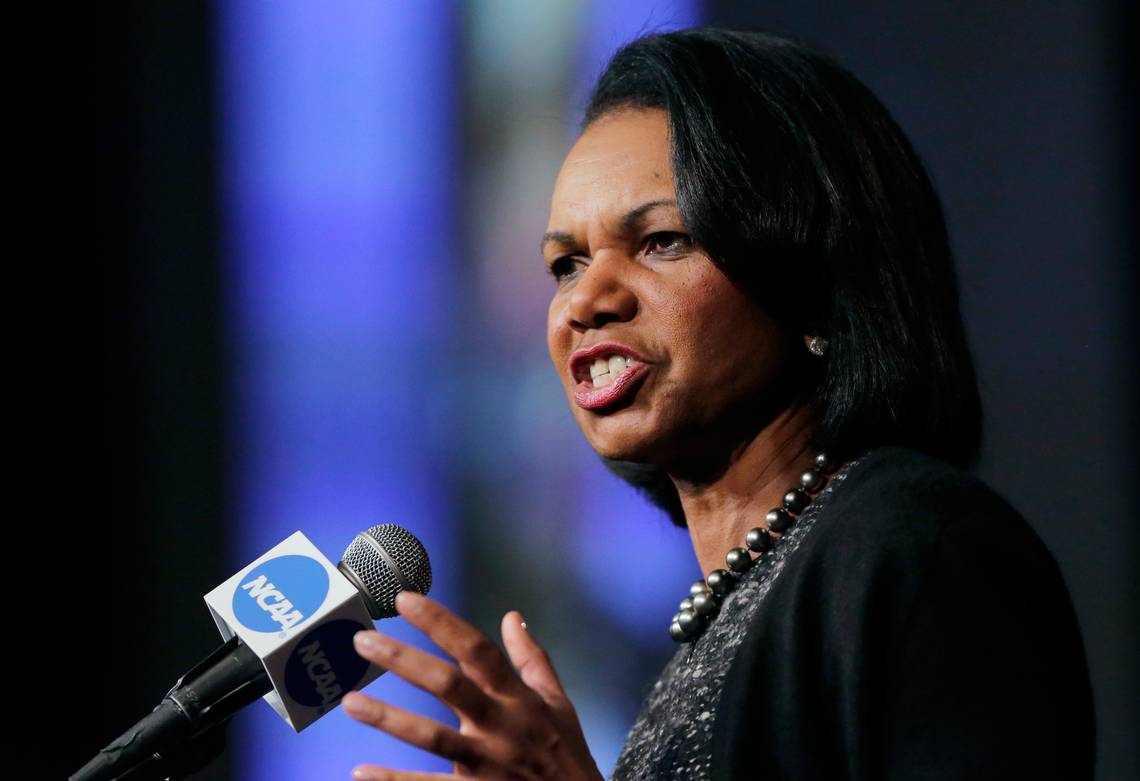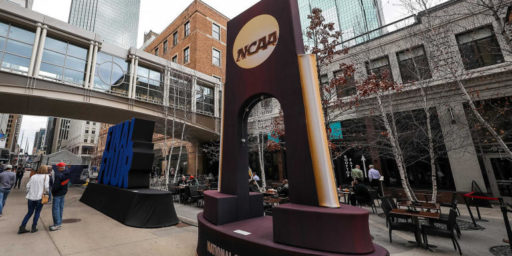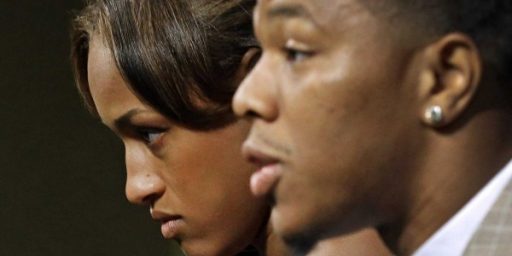Rice Commission Issues NCAA Reform Recommendations
The Commission on College Basketball recommended an end to the one-and-done rule and other major reforms.

The NCAA appointed a committee chaired by former Secretary of State Condoleeza Rice in the wake of a massive cheating scandal in college basketball. Today, it issued its findings.
ESPN (“Commission on College Basketball calls for sweeping reforms by NCAA“):
The Commission on College Basketball recommended an end to the one-and-done rule, potential lifetime bans for rule-breakers and changes to the relationship between the NCAA and apparel companies.
“We need to put the college back in college basketball,” commission chairman and former Secretary of State Condoleezza Rice said Wednesday at a news conference in Indianapolis after the independent panel released a detailed 60-page report.
“Our focus has been to strengthen the collegiate model — not to move toward one that brings aspects of professionalism into the game,” Rice added.
[…]
The committee’s report called the environment surrounding college basketball “a toxic mix of perverse incentives to cheat,” and said that responsibility for the current mess goes all the way up to university presidents.
Ending one-and-done is the biggest change suggested by the commission, even though it’s an NBA rule — which Rice pointed out. The commission wants 18-year-olds to again be eligible for the NBA draft, allowing a path to the pros directly out of high school.
The rule was implemented in 2006 despite the success of straight-from-high-school stars such as LeBron James, Kobe Bryant and Kevin Garnett.
The most significant thing is that the dialogue has been opened up,” committee member and Hall of Famer David Robinson told ESPN’s Get Up on Wednesday. “All these different constituents [NBA, apparel companies, NCAA, coaches, administrators] … came to the table to discuss some of these matters, which were in silos before. It opened up a tremendous dialogue.
“I think we all agree we have to do what’s in the best interests of these kids. We have to give them options, open up their eyes to the reality of the situation: ‘What percent of you are going to play in the pros?’ The rest of them need an education. That is what’s going to be the real value here — going to college. Not so you can skip through college and get to the NBA as quickly as possible.”
If a change is not made to one-and-done, Rice said the commission will look into options, such as making freshmen ineligible or locking a scholarship for three or four years if the recipient leaves a program after one year.
“One-and-done has to go one way or another,” Rice told The Associated Press.
The NBA and NBPA conversations on eliminating the one-and-done rule are centered on the 2020 draft as the earliest possible date for change, league sources told ESPN’s Adrian Wojnarowski on Wednesday. The Players Association’s executive committee, including president Chris Paul, won’t meet until after the NBA season.
The commission also recommends college players should be able to return to school if they go undrafted, as long as they don’t sign a professional contract. As it stands, players can test NBA draft waters without an agent, but must withdraw their name weeks before the draft should they decide to return to school.
“Erroneously entering the NBA draft is not the kind of misjudgment that should deprive student-athletes of the valuable opportunity to enter college or to continue in college while playing basketball,” said Rice, who added that the commission considered, but did not recommend, the “baseball rule” that requires two or three years of college if prospects don’t go straight to the draft out of high school.
[…]
Another change to the current process suggested by the commission would be enabling high school and college players to sign with certified agents before deciding on whether to enter the NBA draft.
NYT (“N.C.A.A. Panel Proposes Reforms, Including End to ‘One and Done’“):
An N.C.A.A. commission chaired by Condoleezza Rice and established last year to respond to federal prosecutors’ charges of widespread bribery and corruption in college basketball proposed several reforms on Wednesday that would alter the sport’s texture without challenging the longtime requirement that the players be amateurs, uncompensated beyond a scholarship for their talents and efforts.
The commission called for an end to college basketball players’ “one-and-done” rule, which would need the approval of the N.B.A. and its players’ union. It anticipated potential future payments to players for the commercial use of their names, images and likenesses, pending the outcome of court cases. It proposed allowing regulated contact with agents. It would overhaul the sanctions system and summer basketball, requiring shoe companies to assume far more “transparency and accountability.”
“The corruption we observed in college basketball has its roots in youth basketball,” Rice said.
The report said: “The levels of corruption and deception are now at a point that they threaten the very survival of the college game as we know it. It has taken some time to get here, and it will take time to change course.”
[…]
The commission also called on the N.C.A.A. to establish a new system for summer basketball, so central to the recruitment process, that would keep out the three main apparel companies — Adidas, Nike and Under Armour. And it proposed allowing players who declare for the N.B.A. draft but are not selected to return to college.
[…]
The commission, which included former players (Grant Hill, David Robinson), former coaches, university presidents, the heads of the Association of American Universities and U.S.A. Basketball, and others, stopped short of taking on the so-called collegiate model, instead tacitly endorsing the status quo, in which athletes are “students first” and barred from all kinds of compensation, even as college basketball has grown into a multibillion-dollar industry.
“Our focus has been to strengthen the collegiate model — not to move toward one that brings aspects of professionalism into the game,” said Rice, the former secretary of state, who was chairwoman of the commission and who delivered a prepared statement at N.C.A.A. headquarters here Wednesday morning.
Yet the commission also acknowledged that the very corruption it sought to eliminate arose in part because of the substantial sums players can generate for high school teams, agents, money managers, college teams, coaches and shoe companies and how this collided with N.C.A.A. rules prohibiting players from taking money beyond a scholarship and related costs of attending school.
“Millions of dollars are now generated by television contracts and apparel sponsorship for the N.C.A.A., universities and coaches,” the report said. “The financial stake in success has grown exponentially; and thus, there is an arms race to recruit the best talent — and if you are a coach — to keep your job.”
No one much likes the “one-and-done” system. The requirement that players be a year out from high school was implemented because James, Bryant, and Garnett are extreme outliers and there were far too many “busts” with 18-year-old kids coming straight into the NBA. Essentially, teams in the Lottery were trying to project whether kids could make it in the Association while fearing missing out on the next James, Bryant, or Garnett. The result was a subversion of the intent of the draft—instead of dramatically improving themselves by taking one of the top six players available, they were often taking a dud. In essence, the rule was protecting general managers from themselves.
The reason so many stay only for a year is because of another, older provision in the NBA collective bargaining agreement that capped rookie contracts for the first three years. That rule was enacted for much the same reason as the one-year-post-high-school rule: Too many teams were signing college players who failed to pan out to massive, guaranteed contracts.
Athletes aren’t required to play college ball for a year, of course. Some top prospects go to Europe or Asia to play in their pro leagues instead. But that’s a move very few 18-year-olds are prepared to make and almost everyone goes to college.
The NBA seems to be rethinking their rules. But, really, if the intent is to “put the college back in college basketball,” there are more massive rules changes needed within the NCAA that emphasize academic performance.
As it now stands, “one-and-done” is really a misnomer in that most of the kids going to the draft after a single season aren’t really “student-athletes” for a year. They drop out right after the season is done, meaning they have no incentive to put any effort into their second-semester studies. And, of course, they’re doing the minimum needed to preserve their athletic eligibility their first semester. Unless we’re going to penalize schools and coaches for students failing to meet academic benchmarks, including graduation, then the “student-athlete” concept is a farce in revenue sports like basketball. (And, yes, the NCAA theoretically tracks graduation rates. But athletes who voluntarily leave school for pro leagues don’t count against those numbers.)
Former Indian Governor and current Purdue University president Mitch Daniels offered some interesting ideas a few months back:
We could require a “year of readiness,” meaning that freshmen could practice but not play while they became acclimated to college life. This was the NCAA rule for many decades, and it makes great sense unless a “student” really has no intention of pursuing a real education.
Or the NCAA could simply use the rule already in effect for baseball, which gives young aspirants a choice between going professional straight from high school or entering college and staying a minimum of three years. Either of these approaches separates those seriously interested in higher education from those forced by the current system to pretend they are.
Another idea would be to allow players to depart early for the NBA, but the scholarships they received would be required to remain vacant for the balance of their four-year terms. Coaches who want to chase that next championship with full-time players masquerading as students could do so, but the following few seasons might be tough with rosters filled with walk-ons.
I’m convinced the college game would be more, not less popular, if a handful of would-be pretend students, whose names fans barely get a chance to know, instead went straight from high school to some sort of professional league. Doing so would certainly bring more parity and fairness to the college game. The play would still be amazingly athletic — most of us fans would not be able to tell the difference — and schools with genuine academic and conduct standards would no longer be at such a competitive disadvantage.
He also makes an interesting point often lost in this conversation:
It’s startling how concentrated the phenomenon is. In the past five years, 45 percent of all “five-star” recruits, and 58 percent of all one-and-dones, have gone to just five schools. Our entire 14-member Big Ten conference, by contrast, has had 9.2 percent of the first category and 6.4 percent of the latter, collectively.
Freshman eligibility happened in my lifetime, if not my memory as a sports fan. Requiring athletes to sit out a year seems a rather harsh solution to a relatively concentrated problem.
The scholarship penalty for schools who sign athletes with no intention of staying is more intriguing. As are harsher punishments, including show-cause hiring penalties, against coaches who violate the rules.
Within the current construct, the notion of paying players always comes up in these debates, but it’s problematic on a number of fronts.
First and foremost, Title IX rules requiring equal treatment for female athletes essentially preclude paying more than nominal sums to athletes in revenue sports even at the schools with lucrative programs—and the revenue simply isn’t there for most schools. Star athletes in college football and men’s college basketball could command millions as pros, so a “stipend” type payout that might be affordable simply doesn’t solve any problem.
Second, they go against the very concept that led to the creation of the NCAA in the first place. In the late 1800s, when college football was becoming a going concern, schools were recruiting “ringers” to gain competitive advantage. That still happens to some extent because the incentive to win is so great, but it’s been mitigated substantially. We could, I suppose, just dispense entirely with the notion that the best players at the best schools in the revenue sports are amatuers; but that will have spin-off effects into the overwhelming preponderance of college sports that involves true student-athletes.
One workaround that has been proposed in recent years is to simply allow athletes to profit on their names, by selling autographs, merchandise, and the like. The argument is that this would really only apply to a relative handful of players and, since the payments wouldn’t be coming from the schools, wouldn’t be impacted by Title IX. I’m sympathetic to this in theory. The problem is that it opens a huge back door for boosters to pay players to come to their schools. It would be next to impossible to discern which of these deals are legitimate and which are pay-to-play.
It may simply be that the rewards of recruiting top athletes to the most popular sports are so high as to make effective regulation impossible. If so, then we should likely stop pretending that the top college football and basketball programs are really contests between student-athletes at all and just spin those off as semi-professional leagues, presumably with some sort of licensing relationship with sponsoring universities.






Allow people to enter the draft at 18, and if they don’t get drafted they can play college and become eligible to enter again at 21. If you don’t enter at 18 you’re eligible anytime. True superstars can enter right out of high school, prime prospects will settle for one-and-done, but most will stay once they enter college.
This should have happened quite some time ago. I recall reading a book called “The Hundred Yard Lie,” by sports columnist Rick Telander. Publisher’s Weekly summarizes the premise, in part as “The crux of the problem, he argues, is hypocrisy–on the part of colleges, which claim they are producing “student athletes,” when they are cheating players academically; coaches, who assert they are building character when, instead, they care only about winning; boosters, who help colleges “buy” the best talent; and the NCAA, which produces little but sanctimonious platitudes in defense of a corrupt system. ”
This book was published in 1989.
It’s not an issue I care much about. But in essence the major sports leagues are using colleges as their minor leagues and farm system, while the colleges don’t pay their athletes.
@Mu:
That was the rule until a decade ago when the NBA collective bargaining agreement changed it, for reasons noted in the post.
That was essentially the old rule; players could petition to enter the draft only under a “hardship” waiver.
To me part of the problem is that universities are too involved with sports. Their athletic programs should serve a academic purpose, and in practice they finance all kinds of sports(One could argue that you would have no competitive Olympic athletes without the universities). I remember Cesar Cielo, a Brazilian Olympic Medalist, that trained with a University in Alabama…
@James Joyner: The old rule didn’t allow you to go to college once you entered the draft. I think that’s baseball only where you get to go twice.
One thing I wonder is why the dynamics are so different between the NFL and the NBA.
NFL players are required to wait at least three years after high school to enter the draft, and there doesn’t seem to be any pressure to move that up, yet the NBA wants to draft players right out of high school.
Why does the NFL want to see how players do at the college level, but the NBA doesn’t?
Another thing that might be interesting would be to decouple the playing time and the student time. That is, a college player earns a year of studies at the school for each season they play, but they don’t have to actually use that year until after their eligibility is up. So a player could play football for four years, try to get drafted, and if they don’t, THEN they could become a full time student without having to worry about playing at the same time.
There’s pretty easy immediate solutions that don’t involve paying players:
1. Allow players to talk to have contact with agents
2. Allow players to keep eligibility even if they declare for the draft.
The only reason either of these things is disallowed is because the NCAA has a vested interest in pretending there is no reason to be a college athlete other than love of the sport.
I bet you’d be a lot more sympathetic to this if all universities said professors can’t profit from their own written work. And it’s for your own good because for all we know you’re being paid to give certain arguments the weight of your academic background.
Funnily enough, that’s a much more noble goal than protecting the competitiveness of an endeavor where people bounce balls back and forth.
This paternalistic nonsense we allow in college sports is insane. Theater majors can be in commercials. English majors can sell books. These rules simply don’t exist in any other facet of America. Hell, it really only exists in the major revenue sports that are majority black.
And it’s not like amateurism is hard. But you don’t see people calling for coaches to have to teach classes and work for free.
@Stormy Dragon: The answer that is given to why the NFL requires people to wait for 3 years after their class graduates is that 18 year old players are not physically mature enough to be safe in the NFL.
I suspect the real reason is that the NFL does not want to hire enough scouts to attend every high school football game in the country each week. There is a much smaller pool playing division 1 college football and all of those games are televised somewhere, giving easy access to game tapes. NBA teams only draft 2 players per year so they only need 60 names on their draft boards. NFL teams need over 200 names, they need a chance to see the players in action.
I do find the one and done frustrating. Nothing emphasizes for you more clearly that you are cheering for laundry (thanks Jerry Seinfeld) than your favourite team turning over the roster every year.
Another rule I’d prefer: players get four-year scholarships, not a series of one-year scholarships that can be revoked. Some schools are moving this way. But in my view, a player who leaves college early for the pros would have still have those scholarship years so, if his career fizzled, he could come back and get his degree.
This. There are ethical college sports that actually promote all the ideals that are just mouthnoise in big time college athletics: it’s called Division 3. Let the pros develop a farm system. Let the students athletes be actual students.
@Console:
For the most part, we’re not paid for our written work. Scholarly publications don’t pay nor does most op-ed type writing. Academic press books seldom make any money, either.
Regardless, I don’t object to paying players for their likeness in theory. The problem, as noted in the OP, is that it becomes a backdoor for paying players to come make the school more competitive.
The rules long predated racial integration. The rationale for treating sports differently than the performing arts, business, and the like is simply that we saw what an unregulated system looked like in sports and decided we needed reforms. Everybody from President Teddy Roosevelt on down was demanding regulation. Even with all the rules, there is still a lot of cheating because people want to win so badly.
Some of the rules that currently apply are rather silly. I agree with suggestions that players be allowed to have agents and enter the draft without losing their eligibility. We do the latter in college baseball without problem (although MLB and NBA are very different systems, owing to the former’s longstanding farm system).
Entry-level coaches do in fact work for free or close to it. Colleges have “graduate assistants” and “interns” who are learning the ropes.
Historically, the trade-off was reasonable enough: We’ll give you a free college education in exchange for first-class coaching, a lot of amenities, a chance to play sports at a high level, and a chance to audition for the pros. That seems like less of a good deal in the last 25-30 years as the money flowing in has exploded. But, again, it’s only a relative handful of college football and basketball players at a handful of schools who aren’t still getting a bargain.